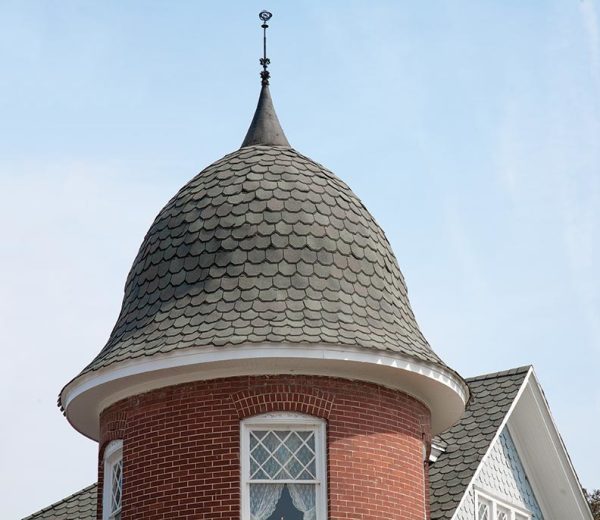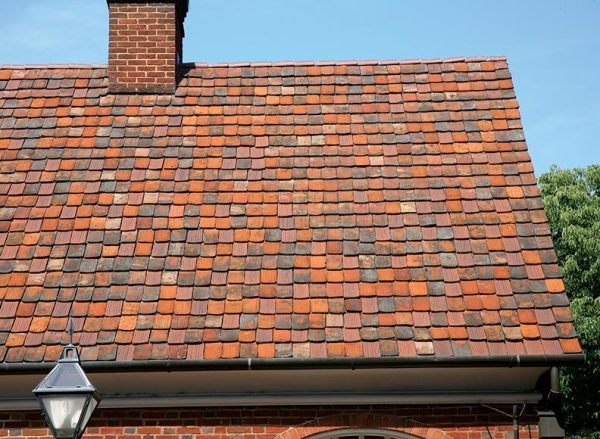
A variegated tile roof adds character to a building.
A roof does much more than shelter the humans who live beneath it—more even than protect the house. Roofs tell tales—about houses and their inhabitants, about time and place, and about style in every sense of the word.
Consider the simple, steep late-medieval roof of early America as it fades into the softer lines of the Federal era’s dignified gabled roof, then onward to the haughty double-sloped Second Empire-style mansard with multiple dormers. The flamboyant cones and spires of late 19th-century Queen Annes; the red-tiled roofs of Spanish Colonials; the broad, low spread of the bungalow roof; and the flat roof of a Modern house—each one has a story to tell. Part of that story has to be about the changing materials from which roofing is made.
From time without measure, built houses were topped with natural materials—wood, stone, or earth. (Terra cotta is literally “baked earth.”) Copper and lead roofs date back to the classic past of Rome and Greece, with iron, tin, and zinc added in the 19th century. Manmade materials only came into general use in the 20th century, particularly the broad mixes of asphalt, felt, and asbestos, as well as modern metal formulations like stainless steel and aluminum. In the recent past, manmade roofing materials have become more common, especially those that mimic natural ones at a lower cost, such as manufactured slates or asphalt shingles that resemble wood.
Today’s roofing is available in a multitude of materials, colors, shapes, and forms that maintain the vintage appearance of originals—matching an original roof as closely as possible should always be a prime goal.
Wood Shingles
(Photo: Courtesy of Custom Cedar Solutions)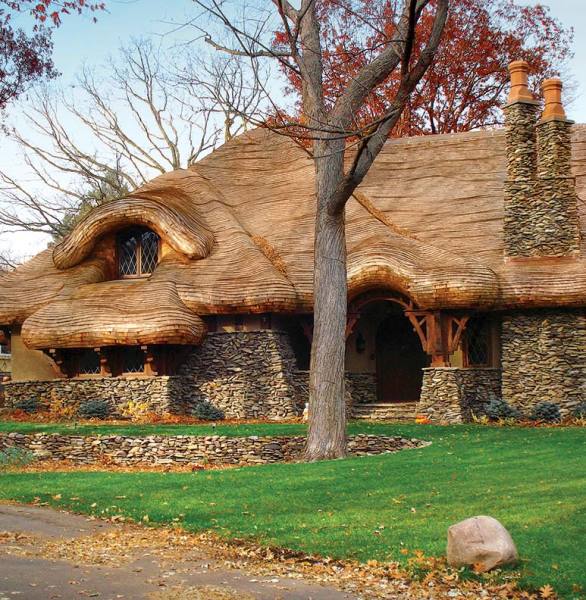
Wood shingles are the oldest type of natural roofing material in the U.S. still in broad general use—they’ve been widely used since the 17th century, both as roofing and wall sheathing. Most often they are cut and dressed, or sawn smooth. Rustic split shakes are mostly a 20th-century phenomenon, becoming popular on 1940s ranch houses, but they don’t belong on earlier homes. Pine, oak, and especially cedar were the traditional shingle materials, with durable cedar being most common today. Bent-shingle “thatch” roofs such as this one are less common, but make a striking presentation on Arts & Crafts and cottage-style houses.
Slate
In the U.S., slate roofing dates to the 18th century; during this time, slates were imported, usually from Wales. After the Civil War, slate of varying quality, durability, and color was widely quarried all over the East, from Vermont to Virginia. Slate remains in use today. Though it is undeniably expensive, it’s probably cost-effective over the potential lifespan of the house itself, since it often lasts for a century or more. In Victorian times, the colors available—dull shades of black, gray, red/purple, green, and blue—were frequently combined to form complex geometric patterns using a variety of butt-end shapes—diamond, square, fish-scale, round, hexagonal, and more. These shapes and colors remain available and in use today, but manmade slate is more common now, though not as durable as the original stone. (Manmade, however, is lighter and less expensive, both often prime considerations for modern homeowners.)
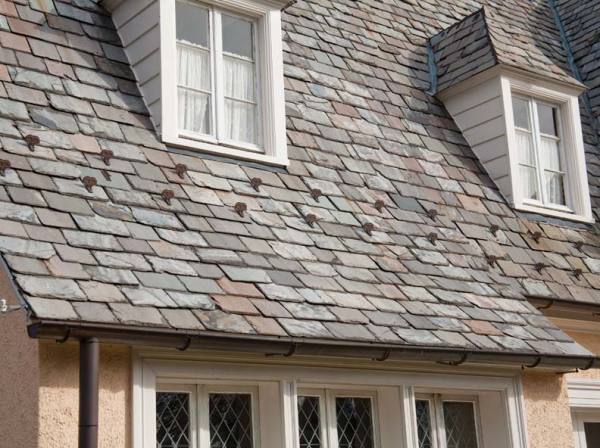
Metal
Metal roofs are constructed of natural materials. In the U.S., lead was rarely used for roofing, and has fallen out of favor. It is nonetheless probably the most permanent of all roofing materials; after a few centuries of use, it could be removed, melted, re-cast, and put back in place. Today, lead-coated copper remains an option.
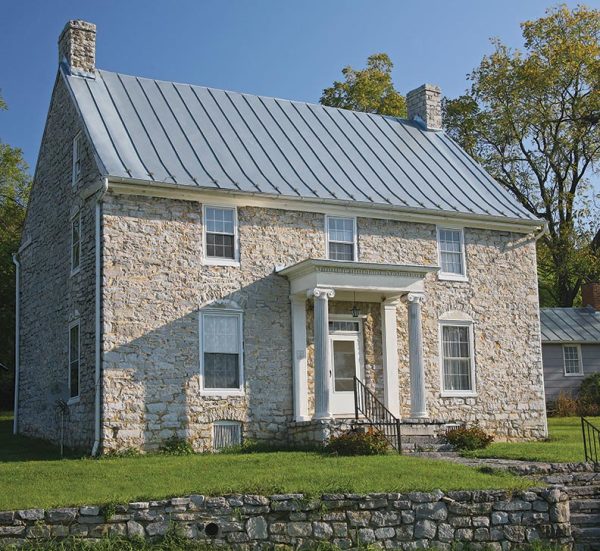
Copper sheets or rolls have been available since the later 18th century and continue in production today. Expensive but long-lasting (more than a century), they are mostly used on mansions, churches, and monumental buildings. “Tin” roofs (correctly called sheet-metal roofs) are increasingly popular today, generally with standing-seam construction. Various kinds of corrugated and crimped tin roofs are most often used in commercial and utilitarian buildings, but they also appeared on very simple houses of the 19th century. In the early 20th century, tin shingles with stamped patterns were popular; they are still used today.
Sheet-metal tin-plate roofing of the 19th century was the first factory-produced roofing, arising in the Federal era. It was initially formed in small sheets with either two or all four edges of each sheet crimped closed, and evolved to be manufactured in increasingly long rolls and installed with crimped edges, today’s standard seamed roofing. Later materials included aluminum and improved tin and zinc alloys, as in galvanized metal. Today, stainless steel may be used in special cases or best examples. Mostly gone now are fast-rusting tin roofs requiring periodic painting. Today, metal roofs come in a range of colors such as dark green, dark red, and aluminum—either factory-finished or painted on site.
Tiles
Tiles, generally of terra cotta, are of ancient origin and were in wide use in the 18th century in Spanish parts of the United States. In the 20th century, as Spanish Colonial and Mission styles spread throughout the country, so did tile roofs. Often overlooked is Germanic settlers’ use of tiles in the 18th century, from New York to North Carolina. Some examples survive at Ephrata Cloisters, Pennsylvania, and Old Salem, North Carolina. In the Spanish colonies, tiles often appeared in barrel (half-round or S) shapes. Ceramic tile with colored glazes, either as shingle tile or curved shapes, came into use in the early 20th century, especially for Beaux Arts mansions. Tiles (both barrel and flat) are in ever-wider use today and are especially valued for being fireproof—no mean consideration in wildfire-prone areas.
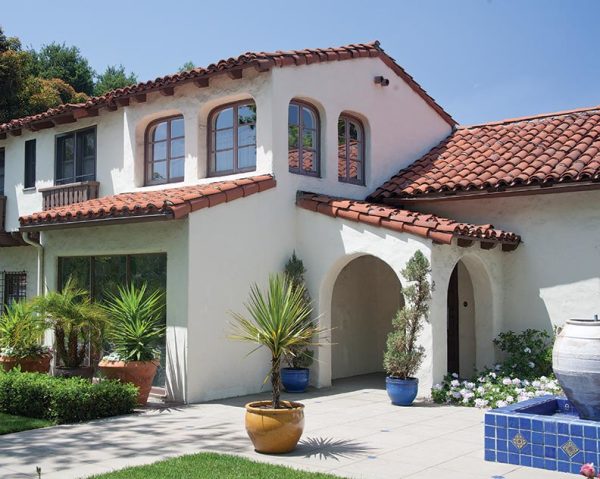
Asphalt
The biggest manufactured-roofing innovation of the mid-19th century was the introduction of shingles and rolls of material composed of asphalt, felt, and a granular coating, which came into wide use in the early 20th century because of their low cost, fire resistance, and ease of installation. They were available in a variety of dark colors and shapes. In improved forms, they are now the most popular type of roofing, generally as strips of shingles. (Roll roofing is used for industrial and secondary structures.) Asphalt shingles vary from very cheap, lightweight models to heavy “architectural shingles” that can be good copies of wood or slate, with excellent shadow lines. The most common shingle design is a rectangular butt-end, but varied shapes are available. Formerly popular was a hexagonal or diamond-shaped self-locking pattern widely available in the first half of the 20th century, and still made by GAF. Owing to environmental concerns, cement-asbestos shingles (and siding, widely used until the 1950s) are no longer used, though they may still be found on old houses.
